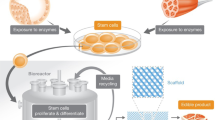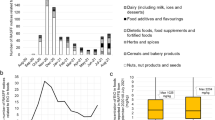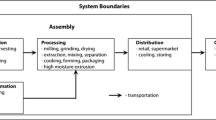Abstract
Purpose of Review
This study reviewed findings on game meat microbiological safety and hygiene published between 2010 and 2020. Data on wild boar, deer, other ruminants, lagomorphs and game birds were analysed.
Recent Findings
In wild game meat, the same zoonotic agents as those found in meat from food-producing animals were identified. A diversity in sampling and laboratory diagnostic methodologies were used and variability of prevalence was observed. Wild boar meat microbiological status seemed more heterogeneous than that of deer. The bacterial mean counts on the carcasses varied between studies. A considerable proportion of carcasses would be classified as “unsatisfactory” by the EU process hygiene criteria.
Summary
The analysed data suggest that more concerted efforts should be carried out to improve the safety of wild game meat and the protection of public health. The inclusion of wild game meat in surveillance and monitoring programmes under the EU Food Law is advisable.
Similar content being viewed by others
References
Papers of particular interest, published recently, have been highlighted as: • Of importance •• Of major importance
Atanassova V, Apelt J, Reich F, Klein G. Microbiological quality of freshly shot game in Germany. Meat Sci. 2008;78(4):414–9.
Gill CO. Microbiological conditions of meats from large game animals and birds. Meat Sci. 2007;77(2):149–60.
El-Ghareeb WR, Smulders FJM, Morshdy AMA, Winkelmayer R, Paulsen P. Microbiological condition and shelf life of meat from hunted game birds. Eur J Wildl Res. 2009;55(4):317–23.
Paulsen P, Winkelmayer R. Seasonal variation in the microbial contamination of game carcasses in an Austrian hunting area. Eur J Wildl Res. 2004;50(3):157–9.
Paulsen P, Smulders FJM, Hilbert F. Salmonella in meat from hunted game: a central European perspective. Food Res Int. 2012;45(2):609–16. https://doi.org/10.1016/j.foodres.2011.06.055.
Miko A, Pries K, Haby S, Steege K, Albrecht N, Krause G, et al. Assessment of Shiga toxin-producing Escherichia coli isolates from wildlife meat as potential pathogens for humans. Appl Environ Microbiol. 2009;75(20):6462–70.
• Sauvala M, Laaksonen S, Laukkanen-Ninios R, Jalava K, Stephan R, Fredriksson-Ahomaa M. Microbial contamination of moose (Alces alces) and white-tailed deer (Odocoileus virginianus) carcasses harvested by hunters. Food Microbiol. 2019;78(May 2018):82–8. https://doi.org/10.1016/j.fm.2018.09.011A high proportion of the harvested moose and white-tailed deer carcasses were of low hygienic quality. High bacterial counts on the carcasses were associated with primitive facilities, outdoor temperature and gut hit.
• Orsoni F, Romeo C, Ferrari N, Bardasi L, Merialdi G, Barbani R. Factors affecting the microbiological load of Italian hunted wild boar meat (Sus scrofa). Meat Sci. 2020;160(June 2019):107967. https://doi.org/10.1016/j.meatsci.2019.107967\.
European Commission. Regulation (EC) No 853/2004 of the European Parlamient and of the Council of 29 April 2004 laying down specific hygiene rules for on the hygiene of foodstuffs. Off J Eur Union. 2004;L 139(853):55.
Avagnina A, Nucera D, Grassi MA, Ferroglio E, Dalmasso A, Civera T. The microbiological conditions of carcasses from large game animals in Italy. Meat Sci. 2012;91(3):266–71. https://doi.org/10.1016/j.meatsci.2012.01.025.
•• Stella S, Tirloni E, Castelli E, Colombo F. Bernardi C. Microbiological evaluation of carcasses of wild boar hunted in a hill area of northern Italy. J Food Prot. 2018;81(9):1519–25 This study assessed the microbial contamination and several hazards for the contamination of hunted wild boar carcasses in Italy.
Mirceta J, Petrovic J, Malesevic M, Blagojevic B, Antic D. Assessment of microbial carcass contamination of hunted wild boars. Eur J Wildl Res. 2017;63(2).
•• Asakura H, Kawase J, Ikeda T, Honda M, Sasaki Y, Uema M, et al. Microbiological quality assessment of game meats at retail in Japan. J Food Prot. 2017;80(12):2119–26 First report on the characterisation of microbiological diversity in sika deer and wild boar meat in Japan, showing variations in hygienic status according to slaughter and/or processing facilities.
Rodas EMF, Bogdanova T, Bossù T, Pecchi S, Tomassetti F, De Santis P, et al. Microbiological assessment of freshly-shot wild boars meat in Lazio Region, Viterbo territory: a preliminary study. Ital J Food Saf. 2014;3(1):49–50.
• Peruzy MF, Murru N, Yu Z, Kerkhof PJ, Neola B, Joossens M, et al. Assessment of microbial communities on freshly killed wild boar meat by MALDI-TOF MS and 16S rRNA amplicon sequencing. Int J Food Microbiol. 2019;301(May):51–60 Comprehensive assessment of microbial communities of wild boar meat.
Gil Molino M, García Sánchez A, Risco Pérez D, Gonçalves Blanco P, Quesada Molina A, Rey Pérez J, et al. Prevalence of Salmonella spp. in tonsils, mandibular lymph nodes and faeces of wild boar from Spain and genetic relationship between isolates. Transbound Emerg Dis. 2019;66(3):1218–26.
Sannö A, Rosendal T, Aspán A, Backhans A, Jacobson M. Distribution of enteropathogenic Yersinia spp. and Salmonella spp. in the Swedish wild boar population, and assessment of risk factors that may affect their prevalence. Acta Vet Scand. 2018;60(1):1–9. https://doi.org/10.1186/s13028-018-0395-3.
Sannö A, Aspán A, Hestvik G, Jacobson M. Presence of Salmonella spp., Yersinia enterocolitica, Yersinia pseudotuberculosis and Escherichia coli O157:H7 in wild boars. Epidemiol Infect. 2014;142(12):2542–7.
Díaz-Sánchez S, Sánchez S, Herrera-León S, Porrero C, Blanco J, Dahbi G, et al. Prevalence of Shiga toxin-producing Escherichia coli, Salmonella spp. and Campylobacter spp. in large game animals intended for consumption: relationship with management practices and livestock influence. Vet Microbiol. 2013;163(3–4):274–81.
Bancerz-Kisiel A, Socha P, Szweda W. Detection and characterisation of Yersinia enterocolitica strains in cold-stored carcasses of large game animals in Poland. Vet J. 2016;208:102–3. https://doi.org/10.1016/j.tvjl.2015.08.010.
Morka K, Bystroń J, Bania J, Korzeniowska-Kowal A, Korzekwa K, Guz-Regner K, et al. Identification of Yersinia enterocolitica isolates from humans, pigs and wild boars by MALDI TOF MS. BMC Microbiol. 2018;18(1):1–10.
Membré JM, Laroche M, Magras C. Assessment of levels of bacterial contamination of large wild game meat in Europe. Food Microbiol. 2011;28(5):1072–9. https://doi.org/10.1016/j.fm.2011.02.015.
• Mirceta J, Petrovic J, Blagojevic B, Malesevic M, Antic D. The microbiological status of carcasses from wild boar in Serbia. Procedia Food Sci. 2015;5:199–202. Available from: https://doi.org/10.1016/j.profoo.2015.09.056. This study assessed the microbial contamination and risk factors for the contamination of hunted wild boar carcasses in Serbia. Two-thirds of the tested carcasses would fall into the category “unsatisfactory” with respect to both ACC and EBC.
Ferroglio E, Bosio F, Trisciuoglio A, Zanet S. Toxoplasma gondii in sympatric wild herbivores and carnivores: epidemiology of infection in the Western Alps. Parasites Vectors. 2014;7(1):2–5.
Santoro M, Viscardi M, Sgroi G, D’Alessio ND, Veneziano V, Pellicano R, et al. Real-time PCR detection of Toxoplasma gondii in tissue samples of wild boars (Sus scrofa) from southern Italy reveals high prevalence and parasite load. Parasites Vectors. 2019;12(1):1–6.
Slany M, Reslova N, Babak V, Lorencova A. Molecular characterization of Toxoplasma gondii in pork meat from different production systems in the Czech Republic. Int J Food Microbiol. 2016;238:252–5. https://doi.org/10.1016/j.ijfoodmicro.2016.09.020.
Gazzonis AL, Villa L, Riehn K, Hamedy A, Minazzi S, Olivieri E, et al. Occurrence of selected zoonotic food-borne parasites and first molecular identification of Alaria alata in wild boars (Sus scrofa) in Italy. Parasitol Res. 2018;117(7):2207–15.
Gazzonis AL, Gjerde B, Villa L, Minazzi S, Zanzani SA, Riccaboni P, et al. Prevalence and molecular characterisation of Sarcocystis miescheriana and Sarcocystis suihominis in wild boars (Sus scrofa) in Italy. Parasitol Res. 2019;118(4):1271–87.
Imre K, Sala C, Morar A, Imre M, Ciontu C, Chisăliță I, et al. Occurrence and first molecular characterization of Sarcocystis spp. in wild boars (Sus scrofa) and domestic pigs (Sus scrofa domesticus) in Romania: public health significance of the isolates. Acta Trop. 2017;167:191–5.
Calero-Bernal R, Pérez-Martín JE, Reina D, Serrano FJ, Frontera E, Fuentes I, et al. Detection of zoonotic protozoa Toxoplasma gondii and Sarcocystis suihominis in wild boars from Spain. Zoonoses Public Health. 2016;63(5):346–50.
Coelho C, Gomes J, Inácio J, Amaro A, Mesquita JR, Pires I, et al. Unraveling Sarcocystis miescheriana and Sarcocystis suihominis infections in wild boar. Vet Parasitol. 2015;212(3–4):100–4. https://doi.org/10.1016/j.vetpar.2015.08.015.
Risalde MA, Rivero-Juárez A, Romero-Palomo F, Frías M, López-López P, Cano-Terriza D, et al. Persistence of hepatitis E virus in the liver of non-viremic naturally infected wild boar. PLoS One. 2017;12(11):1–11.
Mesquita JR, Oliveira RMS, Coelho C, Vieira-Pinto M, Nascimento MSJ. Hepatitis E virus in sylvatic and captive wild boar from Portugal. Transbound Emerg Dis. 2016;63(5):574–8.
Aprea G, Amoroso MG, Di Bartolo I, D’Alessio N, Di Sabatino D, Boni A, et al. Molecular detection and phylogenetic analysis of hepatitis E virus strains circulating in wild boars in south-central Italy. Transbound Emerg Dis. 2018;65(1):e25–31.
De Sabato L, Amoroso MG, Ianiro G, Esposito C, De Grossi L, Fusco G, et al. Detection of hepatitis E virus in livers and muscle tissues of wild boars in Italy. Food Environ Virol. 2020;12(1):1–8. https://doi.org/10.1007/s12560-019-09405-0.
Di Pasquale S, De Santis P, La Rosa G, Di Domenico K, Iaconelli M, Micarelli G, et al. Quantification and genetic diversity of hepatitis E virus in wild boar (Sus scrofa) hunted for domestic consumption in central Italy. Food Microbiol. 2019;82(February):194–201. https://doi.org/10.1016/j.fm.2019.02.005.
Lhomme S, Top S, Bertagnoli S, Dubois M, Guerin JL, Izopet J. Wildlife reservoir for hepatitis E virus, Southwestern France. Emerg Infect Dis. 2015;21(7):1224–6.
Anheyer-Behmenburg HE, Szabo K, Schotte U, Binder A, Klein G, Johne R. Hepatitis E virus in wild boars and spillover infection in red and roe deer, Germany, 2013-2015. Emerg Infect Dis. 2017 [cited 2020 Sep 6];23(1):130–3. Available from: https://doi.org/10.3201/eid2301.161169
Thiry D, Mauroy A, Saegerman C, Licoppe A, Fett T, Thomas I, et al. Belgian wildlife as potential zoonotic reservoir of hepatitis E virus. Transbound Emerg Dis. 2017;64(3):764–73.
Porea D, Anita A, Demange A, Raileanu C, Oslobanu LL, Anita D, et al. Molecular detection of hepatitis E virus in wild boar population in eastern Romania. Transbound Emerg Dis. 2018;65(2):527–33.
Spancerniene U, Grigas J, Buitkuviene J, Zymantiene J, Juozaitiene V, Stankeviciute M, et al. Prevalence and phylogenetic analysis of hepatitis E virus in pigs, wild boars, roe deer, red deer and moose in Lithuania. Acta Vet Scand. 2018;60(1):1–8. https://doi.org/10.1186/s13028-018-0367-7.
Obwegeser T, Stephan R, Hofer E, Zweifel C. Shedding of foodborne pathogens and microbial carcass contamination of hunted wild ruminants. Vet Microbiol [Internet]. 2012;159(1–2):149–54. https://doi.org/10.1016/j.vetmic.2012.03.031, 2012.
Soriano A, Montoro V, Vicente J, Sánchez-Migallón BF, Benítez S, Utrilla MC, et al. Influence of evisceration time and carcass ageing conditions on wild venison quality. Preliminary study. Meat Sci. 2016;114:130–6. https://doi.org/10.1016/j.meatsci.2015.12.021.
Plaza J, Dámek F, Villena I, Innes EA, Katzer F, Hamilton CM. Detection of Toxoplasma gondii in retail meat samples in Scotland. Food Waterborne Parasitol. 2020;20:e00086. https://doi.org/10.1016/j.fawpar.2020.e00086.
• Haindongo N, Nkandi J, Hamatui N, Akai LA, Hemberger MY, Khaiseb S, et al. The prevalence of non-O157:H7 shiga toxin-producing Escherichia coli (STEC) in Namibian game meat. Vet Ital. 2018;54(3):185–8 The first report of non-O157:H7 Shigatoxin-producing Escherichia coli genes in game meat from different species of wild animals in Namibia.
Ota T, Nakano Y, Mizuno T, Shiozaki A, Hori Y, Yamanishi K, et al. First case report of possible Sarcocystis truncata-induced food poisoning in venison. Intern Med. 2019;58(18):2727–30.
Ryll R, Eiden M, Heuser E, Weinhardt M, Ziege M, Höper D, et al. Hepatitis E virus in feral rabbits along a rural-urban transect in central Germany. Infect Genet Evol. 2018;61(December 2017):155–9. https://doi.org/10.1016/j.meegid.2018.03.019.
Abravanel F, Lhomme S, El Costa H, Schvartz B, Peron JM, Kamar N, et al. Rabbit hepatitis E virus infections in humans, France. Emerg Infect Dis. 2017 [cited 2020 Sep 18];23(7):1191–3. Available from: https://doi.org/10.3201/eid2307.170318.
Pasquali F, De Cesare A, Braggio S, Manfreda G. Salmonella detection and aerobic colony count in deep-frozen carcasses of house sparrow (Passer domesticus) and starling (Sturnus vulgaris) intended for human consumption. Ital J Food Saf. 2014;3(2):117–9.
Horigan V, Davies RH, Kelly LA, Mead GC, Irvine RM, Simons RRL. A qualitative risk assessment of the microbiological risks to consumers from the production and consumption of uneviscerated and eviscerated small game birds in the UK. Food Control. 2014;45:127–37. https://doi.org/10.1016/j.foodcont.2014.04.040.
Skorpikova L, Reslova N, Lorencova A, Plhal R, Drimaj J, Kamler J, et al. Molecular detection of Toxoplasma gondii in feathered game intended for human consumption in the Czech Republic. Int J Food Microbiol. 2018;286(April):75–9. https://doi.org/10.1016/j.ijfoodmicro.2018.07.019.
Díaz-Sánchez S, Moriones AM, Casas F, Höfle U. Prevalence of Escherichia coli, Salmonella sp. and Campylobacter sp. in the intestinal flora of farm-reared, restocked and wild red-legged partridges (Alectoris rufa): is restocking using farm-reared birds a risk? Eur J Wildl Res. 2012 [cited 2020 Oct 7];58(1):99–105. Available from: https://link.springer.com/article/10.1007/s10344-011-0547-5
EFSA. The European Union One Health 2018 Zoonoses report. EFSA J 2019;17(12).
De Sabato L, Ostanello F, De Grossi L, Marcario A, Franzetti B, Monini M, et al. Molecular survey of HEV infection in wild boar population in Italy. Transbound Emerg Dis. 2018;65(6):1749–56.
European Commission. Regulation (EC) No 1441/2007 of 5 December 2007 amending Regulation (EC) No 2073/2005 on microbiological criteria for foodstuffs. Vol. 322, Official Journal of the European Union. 2007.
Mateus-Vargas RH, Atanassova V, Reich F, Klein G. Antimicrobial susceptibility and genetic characterization of Escherichia coli recovered from frozen game meat. Food Microbiol. 2017;63:164–9. https://doi.org/10.1016/j.fm.2016.11.013.
Lhomme S, Dubois M, Abravanel F, Top S, Bertagnoli S, Guerin JL, et al. Risk of zoonotic transmission of HEV from rabbits. J Clin Virol. 2013;58(2):357–62.
Guerrero-Ramos E, Cordero J, Molina-González D, Poeta P, Igrejas G, Alonso-Calleja C, et al. Antimicrobial resistance and virulence genes in enterococci from wild game meat in Spain. Food Microbiol. 2016;53:156–64.
European Parliament and Council. Directive 2003/99/EC of the European Parliament and of the Council of 17 November 2003 on the monitoring of zoonoses and zoonotic agents, amending Council Decision 90/424/EEC and repealing Council Directive 92/117/EEC. Off J Eur Union. 2003;2001(October 2003):65–71. Available from: http://ec.europa.eu/information_society/policy/psi/actions_eu/policy_actions/index_en.htm.
European Parliament and Council. Commission Implementing Decision 2013/652/EU of 12 November 2013 on the monitoring and reporting of antimicrobial resistance in zoonotic and commensal bacteria. Off J Eur Union. 2013;(2011):26–39. Available from: https://publications.europa.eu/en/publication-detail/-/publication/83e1934f-4d39-11e3-ae03-01aa75ed71a1/language-en.
EFSA. The European Union Summary Report on Antimicrobial Resistance in zoonotic and indicator bacteria from humans, animals and food in 2017/2018. EFSA J. 2020;18(3).
Seguino A, Chintoan-Uta C, Smith SH, Shaw DJ. Public health significance of Campylobacter spp. colonisation of wild game pheasants (Phasianus colchicus) in Scotland. Food Microbiol. 2018;74:163–70. https://doi.org/10.1016/j.fm.2018.04.002.
Vogt NA, Pearl DL, Taboada EN, Mutschall SK, Janecko N, Reid-Smith R, et al. Epidemiology of Campylobacter, Salmonella and antimicrobial resistant Escherichia coli in free-living Canada geese (Branta canadensis) from three sources in southern Ontario. Zoonoses Public Health. 2018;65(7):873–86.
Bonardi S, Bolzoni L, Zanoni RG, Morganti M, Corradi M, Gilioli S, et al. Limited exchange of Salmonella among domestic pigs and wild boars in Italy. Ecohealth. 2019;16(3):420–8.
Carbonero A, Paniagua J, Torralbo A, Arenas-Montes A, Borge C, García-Bocanegra I. Campylobacter infection in wild artiodactyl species from southern Spain: occurrence, risk factors and antimicrobial susceptibility. Comp Immunol Microbiol Infect Dis. 2014;37(2):115–21. https://doi.org/10.1016/j.cimid.2014.01.001.
Wasyl D, Zajc M, Lalak A, Skaryńska M, Samcik I, Kwit R, et al. Antimicrobial resistance in Escherichia coli isolated from wild animals in Poland. Microb Drug Resist. 2018;24(6):807–15.
Author information
Authors and Affiliations
Corresponding author
Ethics declarations
Conflict of Interest
The authors declare no competing interests.
Human and Animal Rights and Informed Consent
This article does not contain any studies with human or animal subjects performed by any of the authors. The authors did not receive support from any organization for the submitted work.
Additional information
Publisher’s Note
Springer Nature remains neutral with regard to jurisdictional claims in published maps and institutional affiliations.
This article is part of the Topical Collection on Bacteriology
Rights and permissions
About this article
Cite this article
Gomes-Neves, E., Abrantes, A.C., Vieira-Pinto, M. et al. Wild Game Meat—a Microbiological Safety and Hygiene Challenge?. Curr Clin Micro Rpt 8, 31–39 (2021). https://doi.org/10.1007/s40588-021-00158-8
Accepted:
Published:
Issue Date:
DOI: https://doi.org/10.1007/s40588-021-00158-8




